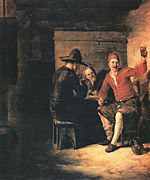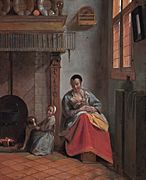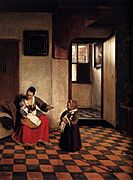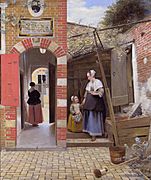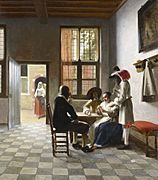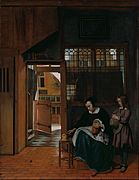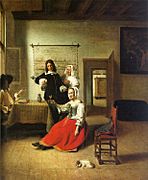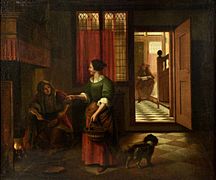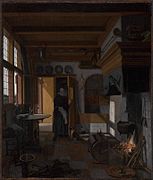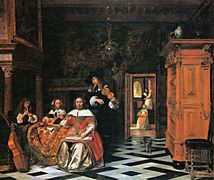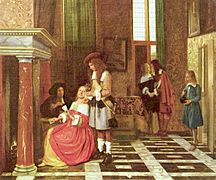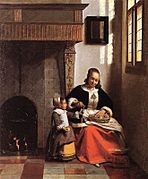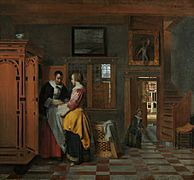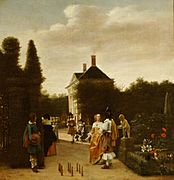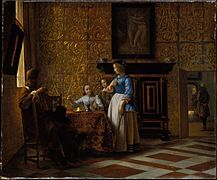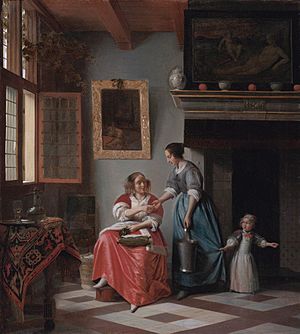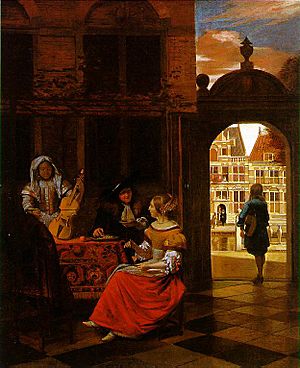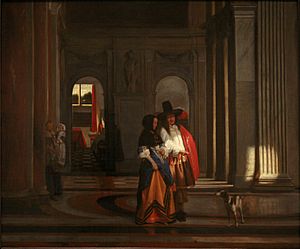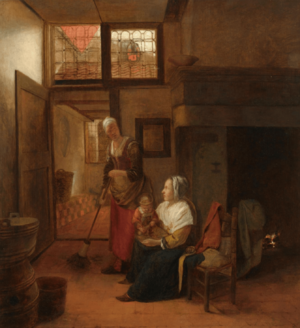Pieter de Hooch facts for kids
Quick facts for kids
Pieter de Hooch
|
|
|---|---|
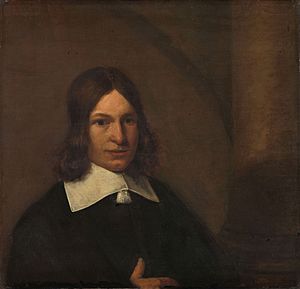
Self-portrait (1652–79)
|
|
| Born | 20 December 1629 Rotterdam, Dutch Republic
|
| Died | 24 March 1684 (aged 54) |
| Nationality | Dutch |
Pieter de Hooch (born December 20, 1629 – buried March 24, 1684) was a famous Dutch Golden Age painter. He is well-known for his paintings of quiet home scenes. Many of his works show open doorways, inviting you to look inside.
Pieter de Hooch lived at the same time as Jan Vermeer in Delft. Both artists were part of the Guild of St. Luke, a group for painters. Their paintings often shared similar ideas and styles.
Contents
About Pieter de Hooch's Life
Pieter de Hooch was born in Rotterdam. His father, Hendrick Hendricksz de Hooch, was a bricklayer. His mother, Annetge Pieters, was a midwife. Pieter was the oldest of five children. He lived longer than all his brothers and sisters.
We don't know much about his early life. Records show he worked in Rotterdam, Delft, and Amsterdam. An early writer, Arnold Houbraken, said Pieter studied art in Haarlem. His teacher was a landscape painter named Nicolaes Berchem.
Around 1650, Pieter worked for a merchant named Justus de la Grange. This merchant also collected art. Pieter traveled with him to places like The Hague and Leiden. In 1652, Pieter moved to Delft. During this time, he likely gave many of his paintings to de la Grange. This was a common way for artists to get paid back then.
Family Life in Delft and Amsterdam
Pieter de Hooch got married in Delft in 1654. His wife was Jannetje van der Burch. They had seven children together. While in Delft, Pieter probably learned from other painters. These included Carel Fabritius and Nicolaes Maes. They were early members of the Delft School.
In 1655, Pieter joined the painters' guild of Saint Luke. This was two years after Vermeer joined. His daughter Anna was born in Delft in 1656. By 1660, Pieter and his family had moved to Amsterdam. Travel between cities was easy then, so moving was not a big problem.
Pieter de Hooch's Artworks
Pieter de Hooch's early paintings showed soldiers and peasants. These scenes were often in stables or taverns. He used these subjects to practice his skills. He became very good at showing light, color, and perspective.
Focus on Home Scenes
After starting his family in the mid-1650s, Pieter changed his focus. He began to paint scenes of home life. These might have been of his own family. His paintings often showed women taking care of children. This could be because his mother was a midwife.
His paintings showed everyday details very well. They also often told a story about good behavior. These artworks used light in a special way, much like Vermeer's paintings. Both artists lived in Delft at the same time.
Comparing De Hooch and Vermeer
De Hooch and Vermeer often painted similar subjects. For a long time, people thought Vermeer influenced de Hooch. But de Hooch was actually one of the first to combine people with indoor spaces. For example, his painting Interior with a Mother and Child and a Servant (around 1656) shows this.
An X-ray of Interior with a Woman Weighing a Gold Coin showed something interesting. De Hooch had painted another figure in the empty chair first. This suggests his painting might have been the original idea that Vermeer later used.
-
Woman Holding a Balance, around 1665 by Vermeer
De Hooch also shared ideas with Emanuel de Witte. However, de Witte mostly painted church interiors after moving to Amsterdam. De Witte focused more on the rooms themselves, filling them with objects. De Hooch was more interested in people and their connections. He kept his rooms simpler, without extra objects.
Later Works in Amsterdam
In the 1660s, Pieter de Hooch started painting for richer people in Amsterdam. He became known for scenes of happy groups and family portraits. These were set in grand rooms with marble floors and high ceilings.
Even in Amsterdam, he continued to paint home scenes. But now, the rooms and the people in them looked much richer.
De Hooch also painted couples playing skittles. One of his best skittle paintings is at Waddesdon Manor. This painting shows how his outdoor scenes changed. He moved from simple Delft courtyards to grand country house gardens. The game of skittles often represented love in art. The woman looking at the viewer is the main character in this "game of love."
Later Years
We don't know much about where de Hooch lived in Amsterdam. But we know he was in contact with Emanuel de Witte. In 1670, he lived in the Konijnenstraat. This area was outside the city walls but near the Westerkerk church, where his family went.
Many experts believe that de Hooch's paintings changed after 1670. They think his style became less detailed and the colors darker. This might have been because his wife died in 1667 when she was only 38. This left him with young children.
After 1680, his painting style became even rougher. It is often said that he died in an asylum in 1684. But it was actually his son, who had the same name, who died there. The exact date of Pieter de Hooch's death is not known.
In 2017, a new research project started. The Delft Prinsenhof museum and the Rijksmuseum worked together. They planned a new exhibition about his works for 2019–2020.
More of Pieter de Hooch's Paintings

For a more complete list of paintings by de Hooch, see the list of paintings by Pieter de Hooch:
- Arrière-cour d'une maison hollandaise – 1650–75. Louvre, Paris
- The Asparagus Vendor – 1675–80 (canvas). Minneapolis Institute of Arts, Minneapolis, Minnesota
- The Bedroom – around 1658 – 1660 (canvas). National Gallery of Art, Washington, D.C.
- A Boy Bringing Bread – around 1663 (canvas). The Wallace Collection, London
- Cardplayers in a Sunlit Room – 1658 (canvas). The Royal Collection, Windsor
- Card Players in an Opulent Interior – 1663–65 (canvas). Louvre, Paris
- Card Players at a Table – around 1670 – 1674 (canvas)
- Children in a Doorway, with 'Colf' Sticks – around 1658 – 1660 (panel)
- Couple in the Morning – 1665 (canvas)
- Couple with a Parrot – c. 1675 (canvas). Wallraf-Richartz Museum, Cologne
- A Couple with Musicians in a Hall – 1663–65 (canvas)
- Courtyard of a Dutch House – 1658 (oil)
- The Courtyard of a House in Delft – 1658 (canvas). National Gallery, London
- Courtyard with Lady and Serving Maid – around 1660 – 1663 (canvas)
- Family Portrait on a Terrace – 1667 (canvas)
- Figures Drinking in a Courtyard – 1658 (canvas on panel)
- A Game of Ninepins – around 1665 (oil). Waddesdon Manor, Buckinghamshire
- Garden Scene with Woman Holding a Glass of Wine, and a Child – around 1658 – 1660
- Guardroom with Smiling Officer, Fluteplayer, and Soldiers – ???? (panel)
- Interior of a Dutch House – around 1658 (oil)
- Interior of the Burgomasters' Council Chamber in the Amsterdam Town Hall, with Visitors – around 1663 – 1665 (canvas)
- Interior with a Mother and Child and a Servant around 1656 Private Collection New York
- Interior with a Young Couple – around 1660–65 (canvas). Metropolitan Museum of Art, New York
- Interior with a Man Reading a Letter and a Woman Sewing – around 1670 – 1674 (canvas). Kremer Collection
- A Man Offering a Woman a Glass of Wine – around 1650–55 (panel)
- A Man Reading a Letter to Woman – around 1670 – 1674 (canvas)
- A Man with Dead Birds, and Other Figures, in a Stable – around 1655 (oil on oak). National Gallery, London
- Merry Company – around 1663 – 1665 (canvas)
- Merry Company with a Man and Two Women – around 1668 – 1670 (canvas)
- A Merry Company with Two Men and Two Women – around 1657 – 1658 (panel)
- The Merry Drinker – around 1650 (panel)
- The Minuet – ???? (canvas)
- Mother and Child with a Serving Woman Sweeping – around 1655 – 1657 (panel)
- Mother and Child with a Serving Woman Sweeping – ???? (canvas)
- A Mother's Duty – around 1658–60 (canvas)
- Mother and Child with Schoolboy Descending a Stair – 1668
- Mother and Infant with Maidservant and a Child – around 1663 – 1665 (canvas)
- Music Party in a Hall, A – around 1663 – 1665 (canvas)
- A Musical Party in a Courtyard – 1677 (oil on canvas). National Gallery, London
- Musical Party on a Terrace, with the Town Hall – around 1667 (canvas)
- Musical Party, A – 1674 (canvas)
- An Officer and a Woman Conversing, Soldier at the Window – around 1663 – 1665 (canvas)
- A Party of Figures Around a Table – around 1663–65 (canvas)
- Paying the Hostess – mid-1670s (canvas). Metropolitan Museum of Art, New York
- Portrait of a Family in a Courtyard in Delft – 1657–60 (oil on canvas)
- Portrait of a Family Making Music – 1663 (canvas)
- Portrait of the Jacott-Hoppesack Family – around 1670 (canvas)
- Saint Peter Liberated from Prison – around 1650–55 (panel)
- Seated Couple with a Standing Woman in a Garden, A – around 1663 – 1665 (canvas)
- Seated Soldier with a Standing Serving Woman, A – around 1652 – 1655 (panel)
- Soldier with an Empty Glass and a Serving Woman, A – around 1650 – 1655 (panel)
- Soldier, Woman, and Messenger – around 1654 – 1657
- Soldiers and Serving Woman with Card Players – around 1665 (oil on canvas)
- Soldiers Playing Cards – 1657–58 (panel)
- Soldiers with a Flute Player and a Serving Woman – ???? (panel)
- Sportsman and a Lady, A – 1684 (canvas)
- Standing Woman Holding an Infant, with a Woman Beside a Candle – ???? (canvas)
- The Maidservant formerly known as Gentleman and Lady in a Bedroom – around 1667 – 1670 (oil on panel)
- Trac-Trac Players – around 1652 – 1655 (oil on panel)
- Two Couples Embracing – around 1673 – 1675 (canvas)
- Two Soldiers and a Serving Woman with Trumpeter – around 1650 – 1655 (panel)
- Two Soldiers and a Woman Drinking in a Courtyard – around 1658 – 1660 (canvas)
- Two Women and a Child in a Courtyard – around 1657 – 1658 (oil on panel)
- Two Women and a Man Making Music – 1667
- Two Women Beside a Linen Chest, with a Child – 1663 (canvas)
- Two Women in a Courtyard – around 1657 – 1660 (canvas)
- Woman and a Young Man with a Letter – 1670 (canvas). Rijksmuseum, Amsterdam
- Woman and Child in a Bleaching Ground, A – around 1657 – 1659 (canvas)
- A Woman with a Child in a Pantry – around 1658 (canvas)
- Woman and Child with a Parrot – 1673
- A Musical Conversation – 1674. Honolulu Museum of Art
- A Woman and her Maid in a Courtyard – around 1660 – 1661 (canvas). National Gallery, London
- Woman Carrying a Bucket and Broom in a Courtyard – ???? (canvas)
- Woman Drinking with Soldiers – 1658. Louvre, Paris
- A Woman Drinking with Two Men, and a Maidservant – 1658 (oil on canvas). National Gallery, London
- Woman Feeding a Parrot, with a Man and Serving Woman – ???? (canvas)
- Woman Lacing Her Bodice Beside a Cradle – around 1661 – 1663 (canvas)
- Woman Nursing an Infant, with a Child and a Dog – around 1658 – 1660 (canvas), in San Francisco
- A Woman Peeling Apples, with a Small Child – around 1663 (canvas). Wallace Collection, London
- A Woman Preparing Bread and Butter for a Boy – around 1660 – 1663, in the Getty Center, Los Angeles
- Woman Preparing Vegetables – ???? (panel)
- Woman Reading a Letter by a Window – 1664 (canvas). Museum of Fine Arts, Budapest
- Woman Reading a Letter, and a Man at a Window, A – around 1668 – 1670 (canvas on panel)
- Woman Reading, with a Child, A – around 1660 – 1663 (canvas)
- Woman Receiving a Letter from a Man, A – around 1668 – 1670 (canvas on panel)
- Woman with a Baby in Her Lap, and a Small Child, A – 1658 (panel)
- A Woman with a Basket of Beans in a Garden – c. 1651 (canvas)
- Woman with a Lute and a Man with a Flute, A – ???? (canvas)
- Woman Weighing Coins – around 1664 (canvas). Kaiser Friedrich Museum-Verein, Berlin
- Wounded Man – around 1667 (canvas)
See also
 In Spanish: Pieter de Hooch para niños
In Spanish: Pieter de Hooch para niños


